
Concept explainers
(a)
Interpretation:
The structure from the given IUPAC name with appropriate stereochemistry is to be drawn.
Concept introduction:
The root name in the given IUPAC name suggests the main chain or ring of carbon atoms in the compound. The suffix to root name indicates the highest priority
The stereochemical designation and the locators are enclosed in parenthesis at the very beginning of the name. The stereochemistry at the chiral center is determined by assigning the priorities to the groups attached to the chiral center on the basis of
Answer to Problem E.48P
The structure for IUPAC name
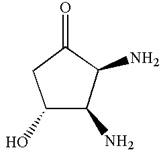
Explanation of Solution
The given IUPAC name is
The root name in this IUPAC name ‘cyclopentan’ represents the main ring of five carbon atoms. The suffix ‘one’ represents the highest priority functional group -
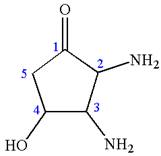
The structure has three chiral centers,
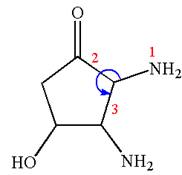
Thus, for absolute configuration
The absolute configuration at
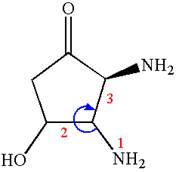
Thus, for absolute configuration
The absolute configuration at
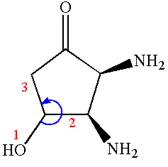
Thus for absolute configuration
Hence, the structure for is
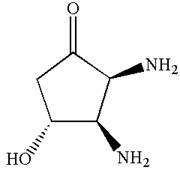
The structure for the given IUPAC name is drawn by identifying the highest priority functional group from the suffix, main chain from root name, and the position for the substituents from the locant with appropriate stereochemistry.
(b)
Interpretation:
The structure from the given IUPAC name with appropriate stereochemistry is to be drawn.
Concept introduction:
The root name in the given IUPAC name suggests the main chain or ring of carbon atoms in the compound. The suffix to root name indicates the highest priority functional group. The prefix with locant number indicates the number of substituents and their respective position at the main chain or at a ring of carbon atoms.
The stereochemical designation and the locators are enclosed in parenthesis at the very beginning of the name. The stereochemistry at the chiral center is determined by assigning the priorities to the groups attached to chiral center on the basis of atomic number of directly bonded atom. If the sequence of priority order
Answer to Problem E.48P
The structure for IUPAC name
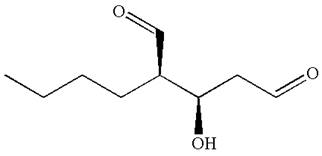
Explanation of Solution
The given IUPAC name is
The root name in this IUPAC name ‘pentane’ represents the main chain of five carbon atoms. The suffix ‘dial’ represents the highest priority functional group
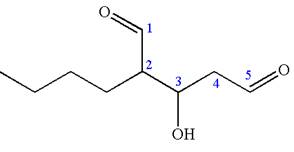
The structure has two chiral centers,
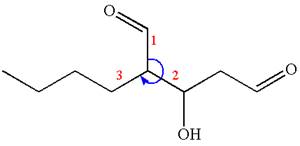
Thus, for the absolute configuration
The absolute configuration at
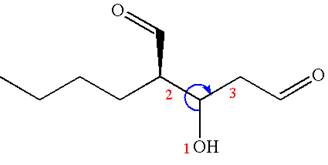
Thus for the absolute configuration
Hence, the structure for
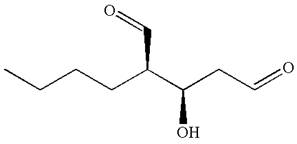
The structure for the given IUPAC name is drawn by identifying the highest priority functional group from the suffix, main chain from root name, and the position for the substituents from the locant with appropriate stereochemistry.
(c)
Interpretation:
The structure from the given IUPAC name with appropriate stereochemistry is to be drawn.
Concept introduction:
The root name in the given IUPAC name suggests the main chain or ring of carbon atoms in the compound. The suffix to root name indicates the highest priority functional group. The prefix with locant number indicates the number of substituents and their respective position at the main chain or at a ring of carbon atoms.
The stereochemical designation and the locators are enclosed in parenthesis at the very beginning of the name. The stereochemistry at the chiral center is determined by assigning the priorities to the groups attached to chiral center on the basis of atomic number of directly bonded atom. If the sequence of priority order
Answer to Problem E.48P
The structure for IUPAC name
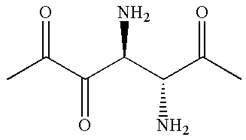
Explanation of Solution
The given IUPAC name is
The root name in this IUPAC name ‘heptane’ represents the main chain of seven carbon atoms. The suffix ‘
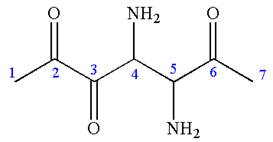
The structure has two chiral centers,
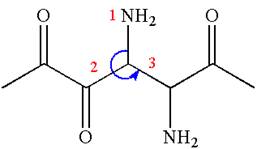
Thus, for the absolute configuration
The absolute configuration at
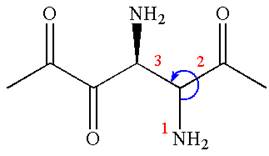
Thus, for the absolute configuration
Hence, the structure for

The structure for the given IUPAC name is drawn by identifying the highest priority functional group from the suffix, main chain from root name and the position for the substituents from the locant with appropriate stereochemistry.
(d)
Interpretation:
The structure from the given IUPAC name with appropriate stereochemistry is to be drawn.
Concept introduction:
The root name in the given IUPAC name suggests the main chain or ring of carbon atoms in the compound. The suffix to root name indicates the highest priority functional group. The prefix with locant number indicates the number of substituents and their respective position at the main chain or at a ring of carbon atoms.
The stereochemical designation and the locators are enclosed in parenthesis at the very beginning of the name. The stereochemistry at the chiral center is determined by assigning the priorities to the groups attached to chiral center on the basis of atomic number of directly bonded atom. If the sequence of priority order
Answer to Problem E.48P
The structure for IUPAC name
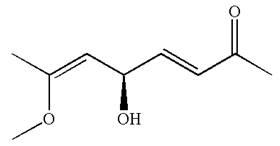
Explanation of Solution
The given IUPAC name is
The root name in this IUPAC name ‘octa’ represents the main chain of eight carbon atoms. The suffix ‘
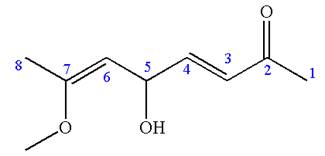
The structure has one chiral center,
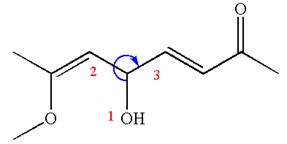
Thus for the absolute configuration
Hence, the structure for
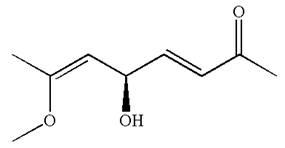
The structure for the given IUPAC name is drawn by identifying the highest priority functional group from the suffix, main chain from root name and the position for the substituents from the locant with appropriate stereochemistry.
Want to see more full solutions like this?
Chapter E Solutions
EBK ORGANIC CHEMISTRY: PRINCIPLES AND M
- For each reaction below, decide if the first stable organic product that forms in solution will create a new CC bond, and check the appropriate box. Next, for each reaction to which you answered "Yes" to in the table, draw this product in the drawing area below. Note for advanced students: for this problem, don't worry if you think this product will continue to react under the current conditions - just focus on the first stable product you expect to form in solution. དྲ。 ✗MgBr ? O CI Will the first product that forms in this reaction create a new C-C bond? Yes No • ? Will the first product that forms in this reaction create a new CC bond? Yes No × : ☐ Xarrow_forwardPredict the major products of this organic reaction: OH NaBH4 H ? CH3OH Note: be sure you use dash and wedge bonds when necessary, for example to distinguish between major products with different stereochemistry. Click and drag to start drawing a structure. ☐ : Sarrow_forwardPredict the major products of this organic reaction: 1. LIAIHA 2. H₂O ? Note: be sure you use dash and wedge bonds when necessary, for example to distinguish between major products with different stereochemistry. Click and drag to start drawing a structure. X : ☐arrow_forward
- For each reaction below, decide if the first stable organic product that forms in solution will create a new C - C bond, and check the appropriate box. Next, for each reaction to which you answered "Yes" to in the table, draw this product in the drawing area below. Note for advanced students: for this problem, don't worry if you think this product will continue to react under the current conditions - just focus on the first stable product you expect to form in solution. NH2 tu ? ? OH Will the first product that forms in this reaction create a new CC bond? Yes No Will the first product that forms in this reaction create a new CC bond? Yes No C $ ©arrow_forwardAs the lead product manager at OrganometALEKS Industries, you are trying to decide if the following reaction will make a molecule with a new C-C bond as its major product: 1. MgCl ? 2. H₂O* If this reaction will work, draw the major organic product or products you would expect in the drawing area below. If there's more than one major product, you can draw them in any arrangement you like. Be sure you use wedge and dash bonds if necessary, for example to distinguish between major products with different stereochemistry. If the major products of this reaction won't have a new CC bond, just check the box under the drawing area and leave it blank. Click and drag to start drawing a structure. This reaction will not make a product with a new CC bond. G marrow_forwardIncluding activity coefficients, find [Hg22+] in saturated Hg2Br2 in 0.00100 M NH4 Ksp Hg2Br2 = 5.6×10-23.arrow_forward
- give example for the following(by equation) a. Converting a water insoluble compound to a soluble one. b. Diazotization reaction form diazonium salt c. coupling reaction of a diazonium salt d. indacator properties of MO e. Diazotization ( diazonium salt of bromobenzene)arrow_forward2-Propanone and ethyllithium are mixed and subsequently acid hydrolyzed. Draw and name the structures of the products.arrow_forward(Methanesulfinyl)methane is reacted with NaH, and then with acetophenone. Draw and name the structures of the products.arrow_forward
- 3-Oxo-butanenitrile and (E)-2-butenal are mixed with sodium ethoxide in ethanol. Draw and name the structures of the products.arrow_forwardWhat is the reason of the following(use equations if possible) a.) In MO preperation through diazotization: Addition of sodium nitrite in acidfied solution in order to form diazonium salt b.) in MO experiment: addition of sodium hydroxide solution in the last step to isolate the product MO. What is the color of MO at low pH c.) In MO experiment: addition of sodium hydroxide solution in the last step to isolate the product MO. What is the color of MO at pH 4.5 d.) Avoiding not cooling down the reaction mixture when preparing the diazonium salt e.) Cbvcarrow_forwardA 0.552-g sample of an unknown acid was dissolved in water to a total volume of 20.0 mL. This sample was titrated with 0.1103 M KOH. The equivalence point occurred at 29.42 mL base added. The pH of the solution at 10.0 mL base added was 3.72. Determine the molar mass of the acid. Determine the Ka of the acid.arrow_forward
 Organic ChemistryChemistryISBN:9781305580350Author:William H. Brown, Brent L. Iverson, Eric Anslyn, Christopher S. FootePublisher:Cengage Learning
Organic ChemistryChemistryISBN:9781305580350Author:William H. Brown, Brent L. Iverson, Eric Anslyn, Christopher S. FootePublisher:Cengage Learning
